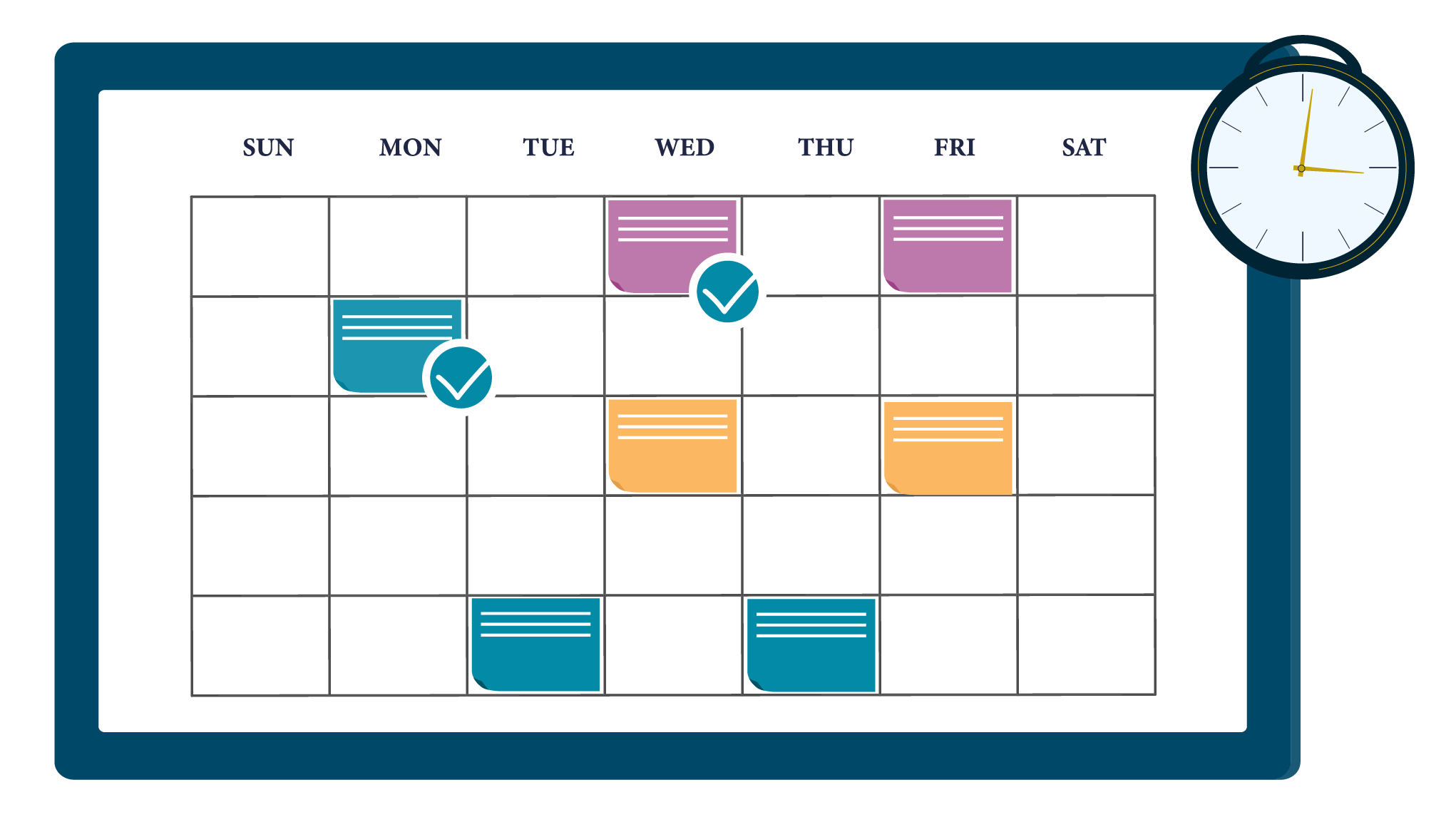During my time with Gold-Vision, I have led or assisted with a number of CRM implementation projects in a wide variety of industries. So, I can say with confidence that a successful CRM implementation relies on six key steps:

In this blog I will go into more detail about each step, sharing my key tips and best practice advice to ensure that your next CRM project is a success.
1) Set realistic and achievable goals for a successful CRM implementation
The best way to ensure a successful CRM implementation is to think about your goals. As a business, what do key stakeholders need from the CRM? Use this need to home in on your business goals. If your key stakeholders have an invested interest with clear goals, the project success will be more measurable and more likely to achieve what it set out to.
Split these goals down by team
Consider for your sales and marketing teams, management team and other business functions. What is this team thinking about? What pain does this team have that a CRM could solve?

Common answers for your Sales team might include:
- Wanting better processes to increase their sales
- Reducing the number of clicks and points of data entry
- Being able to better qualify leads
- Better management of sales team visibility.
For the Management team, it is often the desire to have one centralised view of the customer to improve efficiencies and save on costs. CRM gives the ability to analyse data, having visibility of how data is being entered and how well across the business are also key needs.
From an overall business perspective, we commonly see answers such as the ability to automate tasks, prioritise workload and opportunities and increase customer retention. It’s particularly useful when looking at goals from this higher level to keep in mind your ‘must-haves’ versus your ‘wish-list’. Break your CRM project down to give a practical scope at the beginning of the project, whilst also keeping in mind other elements that can be phased in later.
Bonus tip: Make sure you write down your ‘wish-list’ goals to make it easier to come back to them.

Keep it simple: avoid trying to do too much in one go!
Split your goals into phases that work best for your team, remembering to think of your business culture and training ability of your teams. Be mindful of this from the start and aim for realistic milestones along the way.
We often hear, “We just want something simple”. It’s a common goal identified at the beginning of a project which often turns into “I just want something simple, but it also needs to do all the complicated elements of my process”. Gold-Vision has the power and flexibility to work with you to manage this using expert advice from our consultancy team.

Bonus tip: A good CRM provider will be happy to work through the goal-setting exercise, helping you come up with realistically attainable goals based on what they know is achievable, including the timescale in which they can be achieved.
2) Involve the right people from the start
After determining what you want to achieve from your CRM, think about the people who will be involved during the implementation.
- Customer Project Team:
Decision-makers – the people at a senior level in your business who will become your key stakeholders. They have the authority to make decisions about your CRM and make them quickly.
Super Users – people who will use the CRM day-to-day and understand your business processes. Involve this group in the whole project lifecycle to increase buy-in and adoption rate. After all, the aim is to give people a system that makes day-to-day life easier for them. - CRM Vendor Team:
During your buying process, make sure to ask the CRM sales rep what kind of support is available during the implementation. In Gold-Vision’s case, each new customer has their own experienced CRM Project Consultant. They help you, challenge you, and are responsible for delivering a successful CRM on time and on budget. A good CRM Project Team will take the pressure off your internal team.
A common pitfall of CRM purchases is buying into the dream system that the sales rep has sold you. But often buyers only discover after the implementation stage that expectations aren’t matching up to reality! How can you avoid this? Make sure the sales handover to the implementation team is done well. Ideally, you’re looking for a CRM supplier who has a single team from sales to implementation, and finally to support with on-going account contact to advise you.

Time is the other resource – everyone has busy day jobs with a workload that doesn’t go away when implementing CRM. So, plan carefully, and make time. Allow time to review, get internal feedback and test. Remember, this is your project, so you set the pace. Set open and realistic timescales with your CRM Vendor. Rushing the project at a very busy time could be detrimental to having a successful CRM implementation. Ensure your users will have the opportunity to get to grips with training and provide feedback.

3) Follow a clear, phased implementation plan
When searching for a new CRM solution, I strongly recommend looking for a CRM provider who follows a clear, phased implementation process and who can guide you along the way. To give you an example of how this could work, I will take you through the implementation process we follow here at Gold-Vision.
Planning
We provide clear project planning tools from the beginning to enable the customer to review their key goals and requirements internally first. This then helps the project process go much quicker. It also allows you to have a fully configured system optimised for your business from start to finish within a very short space of time. During your project, we provide regular updates to give you a transparent view of how your CRM project is progressing.

System setup
In this stage, you map out your business process with your consultant. Use the goals originally set to think about your quick wins, your wish list and phasing of your project. At Gold-Vision we work with you to understand your business process and help you understand how best fit with the CRM. During the sales process, we will already have a good understanding of your requirements and processes including sharing any reporting, templates or data samples which you feel are important.
We will then work with you to set up your screens, fields, labels etc. as well as providing some administrative training right at the beginning of your project. You can see easily how to use the Admin area in Gold-Vision, to make screen changes and ultimately feel empowered to make further changes after you go live.
Don’t just think about the fields that you want on your screens but also about workflow in the background and how to improve the way that your teams work. An automated workflow is something that you might think about at the beginning but typically you might come back to later on in your CRM lifecycle.

4) Don’t let dirty data detriment your successful CRM implementation plan
It can be costly to get your data wrong so take time to think about it from the beginning. Think carefully:
- How important is your historic data and do you want to import it all into CRM?
- Consider cleansing your data in advance, it will improve user engagement
- Nurture a culture that everyone who uses the CRM recognises their share of the responsibility to keep the data clean and up to date.
- Engage key team members and have a clear policy and processes for keeping data up to date as part of your guidelines for CRM usage.

Data regulation compliance
Do you have processes in place currently to protect your data? A good CRM solution will have data management functionality built-in so that you can apply your privacy rules to the data and caretaking is automated. Ensure your CRM consultant is aware of anything you currently have (or don’t have) is in place.
Finally, be aware of the data structure of your CRM when deciding on your data – this will help you map where the data needs to go to. Each CRM is different so ask about the import format that your provider uses. Some providers require a strict format for data for import – here at Gold-Vision if you provide a sample, we can provide some helpful tips on cleansing it ready to import.

Bonus tip: Things to consider when reviewing your data:
- Which old data is insightful enough to transfer?
- How many data sources you have?
- How is your data structured?
- Don’t forget to consider data protection
- Do a cost/benefit analysis — poor data = bigger cost & takes longer to migrate.
Want to know more about how to manage your customer data? Download our eBook.
5) Feel confident from the start with training
One of the key elements to successful CRM implementation is choosing a provider who can give you several different options when it comes to training, based around the needs and preferences of you and your teams which also consider your culture. Don’t settle for a provider who only offers stock training, training universities or extremely limited and basic resources as I can guarantee that this will fall far below what you find that you need. Instead, your training should be tailored to your business processes and each training session should be short, concise and easy to follow
Here at Gold-Vision, we offer a variety of web training and in-person training (of course when we’re not involved in a pandemic). This is because, as the software author and specialist, we endeavour to work with the customer to identify their key business processes and make sure that the training revolves around them.

You don’t have to train everyone on everything
It’s a good idea to put together a timetable which will help your users understand which sessions they should go on. By segmenting the sessions into smaller chunks it will help them take everything in and improve the training experience. It’s also worth working closely with your CRM provider when it comes to training, especially if they offer “train-the-trainer” style training, in which an initial ‘super-user’ team who have been involved since the start of the project, are trained on how to use the system. Because they have been involved since the beginning, this ‘super-user’ team will more easily understand how the CRM has been configured, how certain processes work and how the data has been configured. They can then cascade this training out to the rest of the CRM users.

Your CRM consultant is your friend
Alternatively, you may want your CRM provider to be involved in all user training in which case, rather than the super users being involved your CRM consultant will orchestrate and lead the training. Hopefully, by the end of your user training sessions, you will have achieved user acceptance from everyone and will now be in a position to go-live.
You might also want to consider any additional support that some users may need following go-live. Your consultant will be able to provide some helpful tools and reporting to monitor your users CRM usage after training so that you can pick up where necessary.
6) Pick a partner who’ll empower you
No time like the present
Hopefully, having gone live with a successful CRM implementation project, your team will feel empowered to go ahead and use the skills and processes that they’ve learned in the training session. We aim to keep the gap between user training and go live very minimal. In fact, during the training sessions we make it clear to the customer that as soon as you complete your user training, it’s time to start using the system. There shouldn’t be a gap or a ‘big bang day’. Start getting your team empowered to use their everyday processes within the system as soon as possible.

Find a partner you can trust
Ultimately, for your CRM project to work you need to pick the right partner in the first place. At Gold-Vision we like to make the difference and ensure that our CRM product offers value for money, is powerful and intuitive. But more importantly, we always want to ensure that you’ve got all of the tools you need throughout your CRM project to make sure that your system is scalable and future-proof for you. Ultimately, you want to pick a trusted partner who you know is going to work with you along the way and be supportive of the relationship that you’ve got.
Wrapping up
The path to a successful CRM implementation is different for every company, especially as all businesses are unique and have their own set of requirements and challenges. If your organisation recognises the importance of good customer relationship management then a vanilla, out of the box CRM system simply will not do. Instead, you need to find a CRM solution from a provider that will work with you to prioritise a great implementation right from the get-go, enabling you to build something that is truly flexible and works for your business. That is the way to CRM success.
